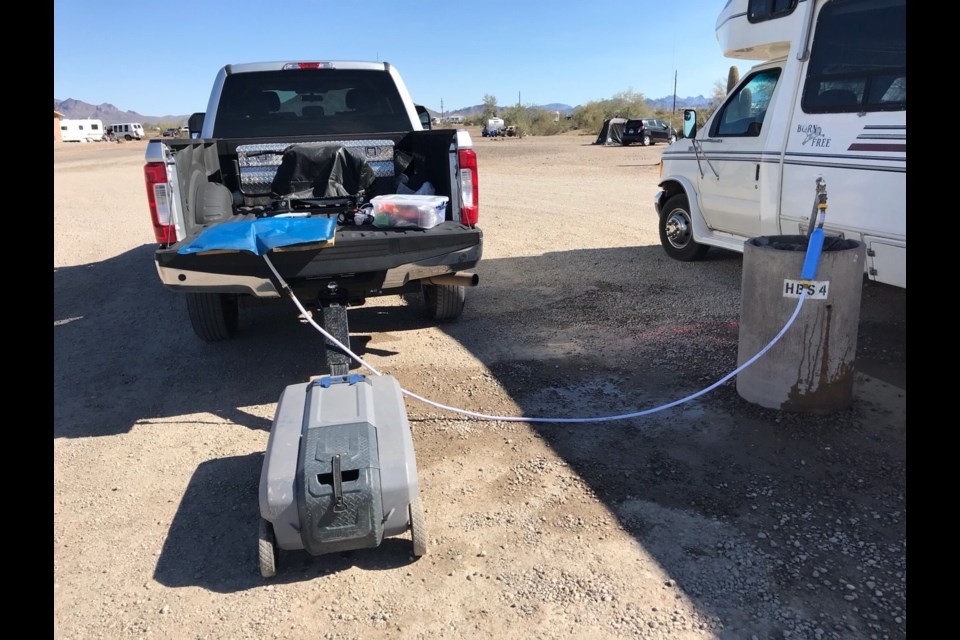Since January 2018, Pierre along with his wife Kerry and their 12-year-old Labrador Kodi have been living and travelling throughout North America in their 32-foot fifth wheel – mostly living off the grid using solar power.
Our favourite kind of camping is to find ourselves in a desert for a couple of months at a stretch, enjoying intensely quiet surroundings with no neighbours in sight, no hook ups to water, electricity or sewage. This is better known as boondocking or dry camping.
Remember to enjoy this type of camping in a respectable, sustainable way.
Some of our most memorable multi-day boondocking locations have been in: California’s Death Valley National Park; in Arizona’s Kaibab National Forest a couple of miles south of the Grand Canyon; on numerous Arizona BLMs (Bureau of Land Management) land and LTVAs (Long Term Visitor Areas); in Tennessee on TVAs (Tennessee Valley Authority - undeveloped public lands); and in New Mexico and Arkansas on National Forest Land.
I’ll focus on a few simple things we do to enhance what’s already a sublime experience.
Solar panels (power)
We use two, 160 watt solar panels on the roof of our fifth wheel ($1,500), two, 12V, deep cycle batteries ($700), and a 2,000 watt inverter to produce electricity within our RV ($900) to power all our electrical outlets with the energy of the sun.
Bladder (water)
This was one of the trickiest to figure out. We needed somehow to transfer water into the RV’s freshwater tank but didn’t want to lug around the large 30 or 50 gallon drums that other people used to hold water. We discovered the answer with a collapsible water bladder. We purchased a bladder that holds 30 gallons of water ($250) and yet when empty, will fold to the size of a three ring binder - fantastic product. Add a $120 transfer pump (smaller in size than a one litre bottle of Pepsi) and a couple of 8ft hoses to transfer the water from the bladder and into the RV’s tank - all components wonderfully small and yet so powerful - and voila, you’ve now got yourself running water in your RV while boondocking.
Waste tank (sewage)
Portable RV sewage totes (often called “blue boys” because they were initially all blue-coloured) come in a number of sizes and styles - ours is 27 gallons on four wheels ($350). Almost everybody who boondocks at the LTVAs in Arizona where there are communal dump stations has a sewage tote. The reason is simple. Rather than hitching up and driving your RV to the dump station every time your black tank is full, it’s much more convenient to empty the black tank into a portable tote. You then attach the tote to the back of your truck on a ball hitch and slowly drive the tote to the dump station. This device has been well worth the pricey investment and has also paid its way many times over. During 2020/2021, when COVID-19 forced us to stay at a campground in the Vancouver area for 13 straight months, we knowingly took a site without a sewage hookup and saved $50 a month or $650 - just because we had a waste tote.
Toilet paper
We never flush toilet paper down our RV toilet. One of the greatest inventions ever is called the Diaper Genie ($45). Rather than potentially clogging your RV’s black tank with toilet paper - especially when you aren’t hooked up to a city water line - we use what people utilize to dispose of their baby’s diapers. Plus we don’t have to buy the higher priced RV-special toilet paper. The Diaper Genie is skinny and tall, fits perfectly in an RV bathroom. Look it up online - you’ll thank me when you do.


